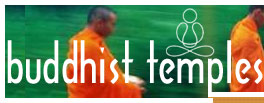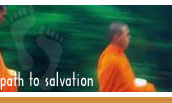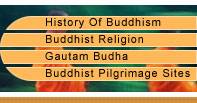While staying at Vaishali, Buddha thrice mentioned to Ananda a Buddha's ability to remain alive till the end of the aeon. Failing to understand the significance of this, Ananda said nothing and went to meditate nearby. Shakyamuni then rejected prolonging his own life span. Later Ananda learned of about this and implored Buddha to live longer. But he was refused, since his request had come too late.
 Coming to Pava, the blacksmith's son, Kunda, offered him a meal, which included meat. It is said that all the Buddhas of this world eat meal, containing meat, on the eve of their passing away. Buddha accepted, but directed that no one else should partake in the food. Later, it was learned that the meat was bad. He told Ananda that the merit created by offering an enlightened one his last meal is equal to that of offering food to him just prior to his enlightenment.
Coming to Pava, the blacksmith's son, Kunda, offered him a meal, which included meat. It is said that all the Buddhas of this world eat meal, containing meat, on the eve of their passing away. Buddha accepted, but directed that no one else should partake in the food. Later, it was learned that the meat was bad. He told Ananda that the merit created by offering an enlightened one his last meal is equal to that of offering food to him just prior to his enlightenment.Between Pava and Kushinagar, Buddha rested near a village through which a caravan had just passed. The owner of the caravan, a Malla nobleman, came and talked to the Buddha. Deeply moved by Shakyamuni's teachings, he offered Buddha two pieces of shining gold cloth. However, their luster was completely outshone by Shakyamuni's radiance. It is said that a Buddha's complexion becomes prodigiously brilliant on both the eve of his enlightenment and the eve of his decease.
The next day, when they arrived at the banks of the Hiranyavati River, situated to the south of Kushinagar, Buddha suggested that they should go to the caravan leader's sala grove. There, between two pairs of unusually tall trees, Shakyamuni lay down on his right side in the lion posture with his head to the north. Ananda asked if Rajgir or Sravasti would perhaps be more fitting places for his passing. Buddha replied that in an earlier life as a bodhisattva king this had been Kushavati, His capital, and at that time there had been no other city has been more glorious.
The noblemen of Kushinagar, informed of the Buddha's impending death, came to pay him respect. Among them was Subhadra, a 120-year-old Brahmin, who was much respected, but whom Ananda had turned away three times. However, Buddha called the Brahmin to His side, answered his questions concerning the six erroneous doctrines, and revealed to him the truth of the Buddhist teaching. Subhadra asked for permission to join the Sangha and thus became the last monk to be ordained by Shakyamuni. Subhadra then sat nearby in meditation, swiftly attained arhantship and entered parinirvana shortly before Shakyamuni.
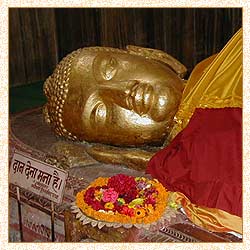 As the third watch of the night approached, Buddha asked His disciples thrice if there were any remaining perplexities concerning the doctrine or the discipline. Receiving silence, He gave them the famous exhortation - "Impermanence is inherent in all things. Work out your own salvation with diligence". Then, passing through the meditative absorptions, Shakyamuni Buddha entered Mahaparinirvana. The earth shook, stars shot from the heavens, the sky in the ten directions burst forth in flames and the air was filled with celestial music. The master's body was washed and robed once more, then wrapped in a thousand shrouds and placed in a casket of precious materials.
As the third watch of the night approached, Buddha asked His disciples thrice if there were any remaining perplexities concerning the doctrine or the discipline. Receiving silence, He gave them the famous exhortation - "Impermanence is inherent in all things. Work out your own salvation with diligence". Then, passing through the meditative absorptions, Shakyamuni Buddha entered Mahaparinirvana. The earth shook, stars shot from the heavens, the sky in the ten directions burst forth in flames and the air was filled with celestial music. The master's body was washed and robed once more, then wrapped in a thousand shrouds and placed in a casket of precious materials.For seven days, offerings were made by gods and men, after which, amidst flowers and incense, the casket was carried to the place of cremation in great procession. Some legends say that the Mallas offered their cremation hall for the purpose. A pyre of sweetly scented wood and fragrant oils had been built, but, as had been foretold, it did not burn until Mahakashyapa arrived. After the great disciple eventually arrived, made prostrations and paid his respects, the pyre burst into flames spontaneously.
After the cremation ceremony was complete, the ashes were examined for relics. Only a skull bone, teeth and the inner and outer shrouds remained. The Mallas of Kushinagar first thought themselves most fortunate to have received all the relics of the Buddha's body. However, representatives of the other eight countries that constituted ancient India also came forth to claim them. To avert a conflict, a Brahmin, Dona, suggested an equal, eightfold division of the relics between them. Some records state that in fact Shakyamuni's remains were first divided into three portions, one each for the gods, nagas and men. The portion given to humans was then subdivided into eight. Each of the eight people took their share to their own countries and eight great stupas were built over them. These relics were again subdivided, after Ashoka decided to build 84,000 stupas. Today, they are contained in various stupas scattered across Asia.
Fa Hien found monasteries at Kushinagar. But, when Huen Tsang came here, the site was almost deserted. He did see an Ashoka stupa marking Kunda's house, the site of Buddha's last meal. Commemorating the Mahaparinirvana was a large brick temple containing a recumbent statue of Buddha. Beside this, was a partly ruined Ashoka stupa and a pillar with an inscription describing the holy event. Two more stupas commemorated the former lives of the Buddha at the place. Both Chinese pilgrims mention a stupa where Shakyamuni's protector Vajrapani threw down his scepter in dismay, after Buddha's death. Some distance away was a stupa, at the place of cremation and Ashoka built another, where the relics were divided.
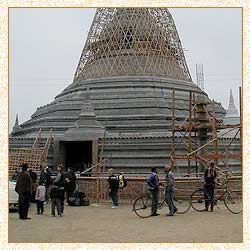 Kushinagar was rediscovered and identified before the end of the last century. Excavations have revealed that a monastic tradition flourished here for a long time. The remains of ten different monasteries, dating from the fourth century to the eleventh century, have been found. Most of these ruins are now enclosed in a park, in the midst of which stands a modern shrine housing a large recumbent figure of the Buddha. This statue was originally made in Mathura and installed at Kushinagar by the monk Haribhadra, during the reign of King Kumaragupta, the alleged founder of Nalanda Monastery. When the statue was discovered, late in the last century, it was broken. However, it has now been restored. Behind this shrine, is a large stupa dating from the Gupta age. The Burmese restored the stupa early in this century. Not far away, is a small temple, built on the Buddha's last resting place in front of the sala grove. It has also been restored. There is a large stupa to the east, now called Ramabhar.
Kushinagar was rediscovered and identified before the end of the last century. Excavations have revealed that a monastic tradition flourished here for a long time. The remains of ten different monasteries, dating from the fourth century to the eleventh century, have been found. Most of these ruins are now enclosed in a park, in the midst of which stands a modern shrine housing a large recumbent figure of the Buddha. This statue was originally made in Mathura and installed at Kushinagar by the monk Haribhadra, during the reign of King Kumaragupta, the alleged founder of Nalanda Monastery. When the statue was discovered, late in the last century, it was broken. However, it has now been restored. Behind this shrine, is a large stupa dating from the Gupta age. The Burmese restored the stupa early in this century. Not far away, is a small temple, built on the Buddha's last resting place in front of the sala grove. It has also been restored. There is a large stupa to the east, now called Ramabhar.On one side of the park, a former Chinese temple has been reopened as an international meditation center. Next to it stands a large Burmese temple. On the south side of the park, there is a small Tibetan monastery, with Tibetan style stupas beside it.

